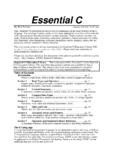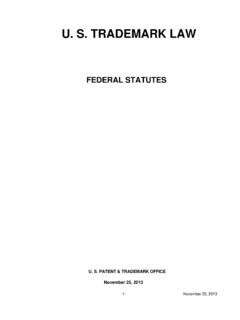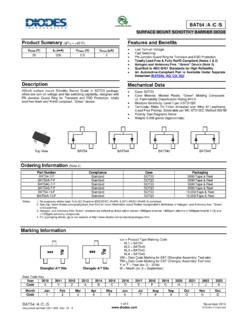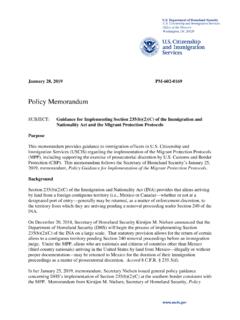Transcription of 2.14AnalysisandDesignofFeedbackControlSystems State ...
1 Analysis and Design of Feedback Control SystemsState-Space Representation of LTI SystemsDerek RowellOctober 20021 IntroductionThe classical control theory and methods (such as root locus) that we have been using inclass to date are based on a simple input-output description of the plant, usually expressedas a transfer function. These methods do not use any knowledge of the interior structure ofthe plant, and limit us to single-input single-output (SISO) systems, and as we have seenallows only limited control of the closed-loop behavior when feedback control is control theory solves many of the limitations by using a much richer descriptionof the plant dynamics.
2 The so-called State -space description provide the dynamics as a setof coupled first-order differential equations in a set of internal variables known asstatevariables, together with a set of algebraic equations that combine the State variables intophysical output Definition of System StateThe concept of thestateof a dynamic system refers to a minimum set of variables, knownasstatevariables, that fully describe the system and its response to any given set of inputs[1-3]. In particular astate-determinedsystem model has the characteristic that:A mathematical description of the system in terms of a minimum set of variablesxi(t),i=1.
3 ,n, together with knowledge of those variables at an initial timet0and the system inputs for timet t0, are sufficient to predict the future systemstate and outputs for all timet> definition asserts that the dynamic behavior of a State -determined system is completelycharacterized by the response of the set ofnvariablesxi(t), where the numbernis definedto be theorderof the system shown in Fig. 1 has two inputsu1(t)andu2(t), and four output vari-ablesy1(t),..,y4(t). If the system is State -determined, knowledge of its State variables(x1(t0),x2(t0),..,xn(t0)) at some initial timet0, and the inputsu1(t)andu2(t) fort t0issufficient to determine all future behavior of the system.
4 The State variables are aninternaldescription of the system which completely characterize the system State at any timet,andfrom which any output variablesyi(t) may be classes of engineering, biological, social and economic systems may be representedby State -determined system models. System models constructed wit ht he pure and ideal(linear) one-port elements (suc has mass, spring and damper elements) are State -determined1 Figure 1: System inputs and models. For suc hsystems t he number of State variables,n, is equal to the number ofindependentenergy storage elements in the system.
5 The values of the State variables at anytimetspecify the energy of each energy storage element within the system and thereforethe total system energy, and the time derivatives of the State variables determine the rateof change of the system energy. Furthermore, the values of the system State variables atany timetprovide sufficient information to determine the values of all other variables in thesystem at that is no unique set of State variables that describe any given system; many differentsets of variables may be selected to yield a complete system description. However, for agiven system the ordernis unique, and is independent of the particular set of State variableschosen.
6 State variable descriptions of systems may be formulated in terms of physical andmeasurable variables, or in terms of variables that are not directly measurable. It is possibleto mathematically transform one set of State variables to another; the important point isthat any set of State variables must provide a complete description of the system. In thisnote we concentrate on a particular set of State variables that are based on energy storagevariables in physical The State EquationsA standard form for the State equations is used throughout system dynamics. In the standardform the mathematical description of the system is expressed as a set ofncoupled first-orderordinary differential equations, known as thestateequations, in which the time derivative ofeac hstate variable is expressed in terms of t he State variablesx1(t).
7 ,xn(t) and the systeminputsu1(t),..,ur(t). In the general case the form of thenstate equations is: x1=f1(x,u,t) x2=f2(x,u,t)..=..(1) xn=fn(x,u,t)2where xi=dxi/dtand eac hof t he functionsfi(x,u,t), (i=1,..,n) may be a generalnonlinear, time varying function of the State variables, the system inputs, and is common to express the State equations in a vector form, in which the set ofnstatevariables is written as astatevectorx(t)=[x1(t),x2(t),..,xn(t)]T ,andthesetofrinputsis written as an input vectoru(t)=[u1(t),u2(t),..,ur(t)]T. Eac hstate variable is a timevarying component of the column vectorx(t).
8 This form of the State equations explicitly represents the basic elements contained inthe definition of a State determined system. Given a set of initial conditions (the values ofthexiat some timet0) and the inputs fort t0, the State equations explicitly specify thederivatives of all State variables. The value of each State variable at some time tlater maythen be found by direct system State at any instant may be interpreted as a point in ann-dimensionalstatespace, and the dynamic State responsex(t) can be interpreted as a pat hor trajectory tracedout in the State vector notation the set ofnequations in Eqs.
9 (1) may be written: x=f(x,u,t).(2)wheref(x,u,t)isavectorfunc tion withncomponentsfi(x,u,t).In this note we restrict attention primarily to a description of systems that arelinearandtime-invariant(LTI), that is systems described by linear differential equations with constantcoefficients. For an LTI system of ordern,andwithrinputs, Eqs. (1) become a set ofncoupled first-order linear differential equations wit hconstant coefficients: x1=a11x1+a12x2+..+a1nxn+b11u1+..+b1rur x2=a21x1+a22x2+..+a2nxn+b21u1+..+ xn=an1x1+an2x2+..+annxn+bn1u1+..+bnrur(3 )where the coefficientsaijandbijare constants that describe the system.
10 This set ofnequations defines the derivatives of the State variables to be a weighted sum of the statevariables and the system (8) may be written compactly in a matrix form:ddt = ann + bnr (4)which may be summarized as: x=Ax+Bu(5) the State vectorxis a column vector of lengthn, the input vectoruis a column vectorof lengthr,Ais ann nsquare matrix of the constant coefficientsaij,andBis ann rmatrix of the coefficientsbijthat weight the Output EquationsAsystemoutputis defined to be any system variable of interest. A description of a physicalsystem in terms of a set of State variables does not necessarily include all of the variables ofdirect engineering interest.














